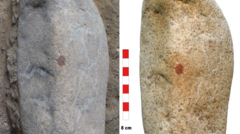A recent study indicates that bedbugs have thrived alongside humans for at least 245,000 years, evolving from bat parasites into our most persistent urban pest.
Bedbugs: Humanity's Longstanding Unwanted Guests

Bedbugs: Humanity's Longstanding Unwanted Guests
New research reveals the centuries-old connection between bedbugs and humans, dating back thousands of years.
In an unexpected evolutionary journey, bedbugs have established a unique bond with humans that stretches back approximately 245,000 years, according to a new study published in the journal Biology Letters. The research unveils the insects’ transition from living off bat blood to becoming dedicated parasites of early humans, marking them as the first urban pests.
The bedbug species most familiar to us, Cimex lectularius, found its opportunity when humans began residing in caves, seeking shelter and warmth. It appears these pests took advantage of the presence of early humans — possibly Neanderthals — as an alternative food source. As the relationship developed, the bedbug shifted away from its original hosts and carved out a niche solely dependent on human sustenance.
Warren Booth, a professor of urban entomology at Virginia Tech and the study's lead author, highlights that bedbugs have no inclination towards external environments. "You’re not going to find a bedbug in your garden," Booth explains, emphasizing their reliance on human habitation for survival and propagation.
While bedbug populations experienced a decline during the nomadic phases of early human existence, this trend reversed around 13,000 years ago with the advent of more permanent settlements. These pests have since flourished, adapting seamlessly to human domestic life. Despite their unpleasant reputation and the discomfort they bring with their bites, bedbugs do not pose a significant health risk, as they currently don't transmit disease.
As cities thrive with human populations, bedbugs continue to thrive as relentless companions, demonstrating nature’s ability to adapt and evolve alongside its hosts. This uninvited cohabitation highlights the complexities of urban living, leaving us to wonder just how intrinsic this pest’s presence truly is in our societal narrative.
The bedbug species most familiar to us, Cimex lectularius, found its opportunity when humans began residing in caves, seeking shelter and warmth. It appears these pests took advantage of the presence of early humans — possibly Neanderthals — as an alternative food source. As the relationship developed, the bedbug shifted away from its original hosts and carved out a niche solely dependent on human sustenance.
Warren Booth, a professor of urban entomology at Virginia Tech and the study's lead author, highlights that bedbugs have no inclination towards external environments. "You’re not going to find a bedbug in your garden," Booth explains, emphasizing their reliance on human habitation for survival and propagation.
While bedbug populations experienced a decline during the nomadic phases of early human existence, this trend reversed around 13,000 years ago with the advent of more permanent settlements. These pests have since flourished, adapting seamlessly to human domestic life. Despite their unpleasant reputation and the discomfort they bring with their bites, bedbugs do not pose a significant health risk, as they currently don't transmit disease.
As cities thrive with human populations, bedbugs continue to thrive as relentless companions, demonstrating nature’s ability to adapt and evolve alongside its hosts. This uninvited cohabitation highlights the complexities of urban living, leaving us to wonder just how intrinsic this pest’s presence truly is in our societal narrative.






















